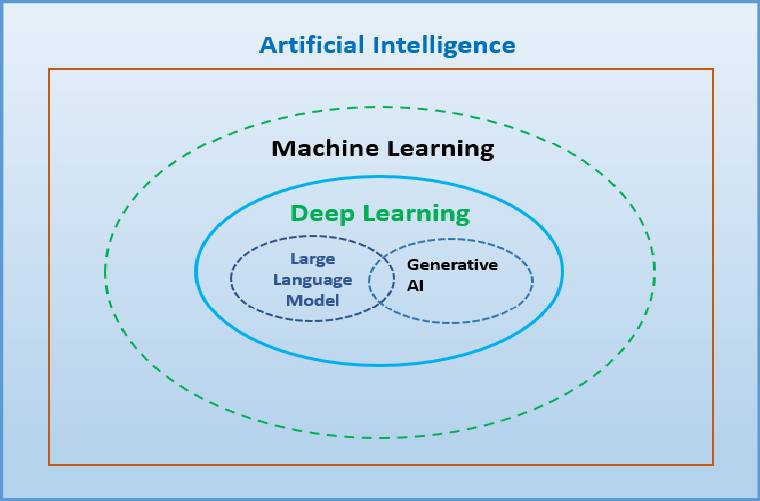Overview
The term artificial intelligence has become prominent in recent years. With tools like ChatGPT gaining widespread attention, artificial intelligence often appears in public discussion and technical coverage.
Alongside artificial intelligence, related terms such as machine learning and deep learning are frequently used. This article explains what these terms mean and how they relate to each other.
Artificial Intelligence
Artificial intelligence was proposed by John McCarthy in 1956, originally defined as the science and engineering of making intelligent machines. Today it refers to the study and development of theories, methods, techniques, and application systems that simulate, extend, or augment human intelligence. In short, artificial intelligence aims to enable machines to perceive, reason, and make decisions in ways similar to humans.
AI is an interdisciplinary field involving computer science, psychology, linguistics, logic, and philosophy. Examples of AI applications include autonomous driving, face recognition, intelligent robots, and machine translation.
AI systems are often classified by capability into three categories:
- Artificial Narrow Intelligence (ANI): Systems specialized in a single task. For example, a face recognition system can only identify faces and cannot answer questions about the weather.
- Artificial General Intelligence (AGI): Human-level intelligence capable of understanding, learning, and applying knowledge across multiple domains. AGI remains a long-term research goal and has not yet been achieved.
- Artificial Superintelligence (ASI): A hypothetical intelligence that surpasses human intelligence across all domains. ASI is currently a theoretical concept and has not been realized.
For example, AlphaGo defeated the world champion in the game of Go, but its capability is limited to that domain. It would not perform well at other board games without retraining, so AlphaGo is an example of Artificial Narrow Intelligence.
Machine Learning
Machine learning is the core approach for realizing artificial intelligence. Like humans who learn from experience, machines learn from data to discover patterns and improve decision-making. Machine learning studies how to enable computers to simulate or implement human learning behavior and acquire new knowledge or skills from data.
Machine learning is an interdisciplinary area involving probability theory, statistics, approximation theory, and computational complexity, among others.
The human learning process can be summarized as:
- Attend class: acquire theoretical knowledge
- Review and summarize: reinforce understanding
- Organize knowledge: form a structured framework
- Practice exercises: deepen understanding through practice
- Periodic tests: evaluate mastery
- Address gaps: improve learning methods
- Final exam: assess overall results
The machine learning process follows similar phases:
- Data collection: gather relevant data
- Data processing: transform and standardize data
- Model selection: choose an appropriate algorithm
- Model training: train the model using data and optimize the algorithm
- Model evaluation: assess model performance based on predictions
- Model tuning: adjust parameters to improve performance
- Prediction: make predictions on new, unseen data
In essence, machine learning uses algorithms to automatically infer rules or logic from data, then applies those rules to make predictions on new data. For example, to teach a computer to recognize dogs, you provide many labeled images of dogs during training. The model learns discriminative features and can then classify new images as dogs. If the algorithm is imperfect, it may confuse dogs with cats, requiring more data or algorithmic improvements to reduce errors.
Types of Machine Learning
- Supervised learning: Learn from labeled data where inputs and outputs are provided. Common tasks include classification and regression.
- Classification: Predict the category of data, such as spam detection or species identification.
- Regression: Predict continuous values, such as house price or height based on features.
- Unsupervised learning: Analyze unlabeled data to discover patterns, such as clustering and dimensionality reduction.
- Clustering: Group similar items without predefined labels, for example customer segmentation.
- Dimensionality reduction: Compress high-dimensional data into lower-dimensional representations, for example combining mileage and years of use into a wear metric.
- Semi-supervised learning: Use a dataset where only part of the data is labeled. Typically apply unsupervised techniques to structure the data, then supervised learning to refine the model and predict labels for unlabeled samples.
- Reinforcement learning: Learn by interacting with an environment and optimizing behavior through rewards and penalties until a policy that maximizes cumulative reward is found. For example, a vacuum robot refines its cleaning path after bumping into obstacles.
Deep Learning
Deep learning is a subfield of machine learning that uses multi-layer neural networks to learn complex representations of data. It enables machines to learn hierarchical features from raw input, which allows them to perform tasks such as recognizing text, images, and audio.
Unlike traditional machine learning where features are often handcrafted, deep learning models learn features automatically through layered transformations. The "depth" refers to the number of layers in the neural network, and deeper networks can extract higher-level abstractions from data.
Common deep learning architectures include:
- Convolutional Neural Network (CNN): commonly used for image recognition and classification.
- Recurrent Neural Network (RNN): suited for sequence data such as natural language.
- Long Short-Term Memory (LSTM): a special RNN variant that handles long-range dependencies in sequences.
- Generative Adversarial Network (GAN): used to generate new data such as images, audio, or text.
Summary
Artificial intelligence is a broad concept that aims to enable machines to think and perform tasks similar to humans.
Machine learning is a major approach to achieve artificial intelligence; it focuses on learning patterns from data. Traditional machine learning often requires manual feature engineering.
Deep learning is a branch of machine learning based on neural networks that can automatically learn feature representations from data.
 ALLPCB
ALLPCB








